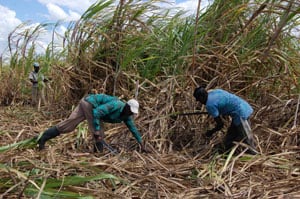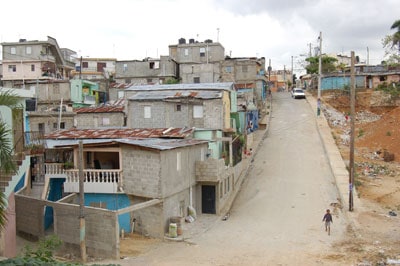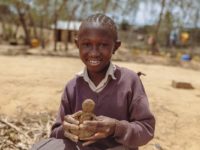The Dominican Republic has a population of about 9.6 million people. Of that, 73 percent are of mixed race, 16 percent are Caucasian, and 11 percent are of African descent. Around 95 percent are Catholic. There is freedom of faith in the country, which allows around 2 percent of the population to practice Voodoo.
A typical Dominican family has four people. Statistically, while 42 percent of the homes are run by both parents together, about 31 percent are run by single mothers, and the rest are run by relatives.
The Dominican Republic is divided into 31 provinces. Eight are in the southeastern region of the country: Distrito Nacional, El Seibo, Hato Mayor, La Altagracia, La Romana, Monte Plata, San Pedro de Macoris and Santo Domingo.
Each province depends on the central government. Each, however, also has its own local authorities: governor, senators, deputies, mayor, etc.
Families living in extreme poverty in the southeastern region of the Dominican Republic work hard to get two meals a day. The situation gets more difficult when drought limits cultivation of small crops like sweet potatoes, corn and plantains, which are the main ingredients in common meals.
In these communities, there are no steady jobs and the residents need to either travel out of the community to find a steady job or stay around their neighborhood looking for small jobs, for which they might get paid around $8 for a full day of work.
The saddest part in this scenario occurs when the children reach adolescence and find they need to help with family income. In the urban areas, children work at traffic lights selling a large variety of items, cleaning windshields, or begging by each car window.
Many times children also get involved in very risky money-generating activities like scavenging in the dump, drug trafficking, and child prostitution. Many times children will abandon school at this point.
 Regarding child labor, there’s been some improvement in light of the sugarcane industry’s announcement that it won’t hire anyone under the age of 18. Nevertheless, children can be seen helping their parents plant and collect sugarcane in the southeast. A cutter is paid between $4.50 and $5.50 for every ton of sugarcane cut and loaded on the wagons.
Regarding child labor, there’s been some improvement in light of the sugarcane industry’s announcement that it won’t hire anyone under the age of 18. Nevertheless, children can be seen helping their parents plant and collect sugarcane in the southeast. A cutter is paid between $4.50 and $5.50 for every ton of sugarcane cut and loaded on the wagons.
In Batey Las Pajas in San Pedro de Macoris, families usually try to raise goats or cows. Animals are a source of income in times of great need, like when a family member gets too sick and needs medicine. But cattle rustlers sometimes steal the animals, leaving only bloody fur in the fields. These thefts drastically affect the economy of families in extreme poverty.
Primary and high school education is generally available in the southeast. Schools in some communities teach primary school only, and students often have to travel to a neighboring town to attend high school. University is a dream that just a few see come true, which is why our church partners provide technical vocational training courses to the children at their development centers. The churches want to equip the children with the skills to generate income for themselves and their families.
The weather is a sensitive issue in the region because of the passage of hurricanes. Every year, tropical storms and hurricanes affect the southeastern region causing landslides and flooding. Thousands of families are left homeless almost every year, and some people die.
Earthquakes have not been a concern in recent years; however, after the earthquake in Haiti on Jan. 12, 2010, all the residents near the southeastern coast were warned to leave their homes and go to more distant higher grond because of a tsunami warning for the Caribbean zone. Even though there was not a tsunami, the fear that one could occur at any time remains in people’s minds.
Examples of child development centers located in areas like this include:
DR-120, 126, 130, 160, 161, 163, 203, 243-245, 249, 256, 290, 292, 302, 304, 308, 309, 315, 320, 340, 347, 349, 366, 368, 369, 371, 375, 384, 385, 389, 401, 401, 407, 408, 411, 412, 420, 431-437, 450-454, 456-458, 461-465, 468, 480, , 482-484, 491, 521-523, 525, 527, 528, 530-533, 535, 536, 540, 550, 630-635, 701, 705-707, 710, 720, 810, 900, 901 and 915.
Batey Aleman, which is part of DR-002, is in the San Pedro de Macoris province and is part of the Dominican southeast.

View of a neighborhood near DR-245
Donplines Recipe
A typical dish in the southeast is donplines, or dumplings, boiled balls of dough.
Ingredients: wheat flour, water and salt. (Because wheat flour makes very soft dough, some people use corn flour instead, for stiffer dough.)
Put water in a deep pan and place over the stove flame until water starts to boil. Simultaneously, put some water in a small bowl and add a little salt to taste and mix.
Put wheat flour in a bowl, pour some of the salt-seasoned water in it and start to mix and knead until you get soft dough.
Take little pieces of dough and shape them all into half-inch-thick and 3-inch-long chunks and submerge them into the boiling water in the pan.
Boil the dough chunks for around 20 minutes or until they are well cooked.
When the donplines are cooked, turn off the stove and serve them hot, either with codfish in red sauce, fried sausage, fried eggs, herring or any other food.







3 Comments |Add a comment
As a missionary to that area, sugarcane is the main industry and does have a monopoly for jobs in the batays. While they provide a form of housing, it is deplorable, basically just a shelter about the size of a horse stall, with no running water, no toilets, and no streets. When it rains, there are just ruts with mud in them to get around. Many of the people there are born there, live there and die there without ever leaving the plantation. There is little education, and many do not even know their birthdate or how old they are. The bathrooms are outhouses at best, at worst, a hole in the ground surrounded by some corregated steel for privacy. Water is infested with bacteria, and the source is a nearby river. Some purchase purified water bottles if they can afford it so the parasites don’t eat their insides alive.
It appears the industry has done little or nothing to improve working conditions or life for these folks. Fortunately they do allow our mission teams in to provide medical care annually, and some potential training and education. There is still so much to be done, that could be done!
Thanks for your help and support for the sake of the children in need in our country.
Even though sugar cane works have been phasing out in some regions since the beginning of the 90’s, it still continues to be a main industry especially in the East of our country, more specifically in the provinces of San Pedro and La Romana. There’s been a lot of denounces against the industry in the past, which have made the owners to proceed more wisely in terms of not allowing children to get involved in the fields. Not important improvement as to wages. Something positive is that the owners have allowed the churches to help improve the living conditions of the residents at the bateyes.
San Pedro, La Romana and Higuey are three provinces where tourism (hotels and related businesses like restaurants, spas and fun places) is a main industry too, and they are the main sources of jobs there.
Great article — very good information on the Dominican Republic. Thank you Adones Martinez for taking the time to write this!
I have a question. It sounds like the sugarcane industry is the main industry in this region. Do the owners of these sugarcane businesses show any interest in improving wages or improving conditions within the community? It sounds like a step forward that they are no longer hiring children under 18. Does that show that they are trying to move in a positive direction on behalf of the community?
Also, are there any other industries that people can work in, in that region? Or does the sugarcane industry have a monopoly on jobs?